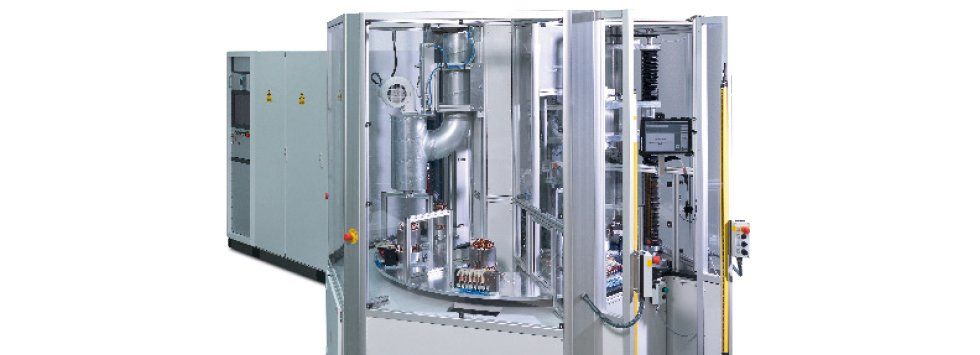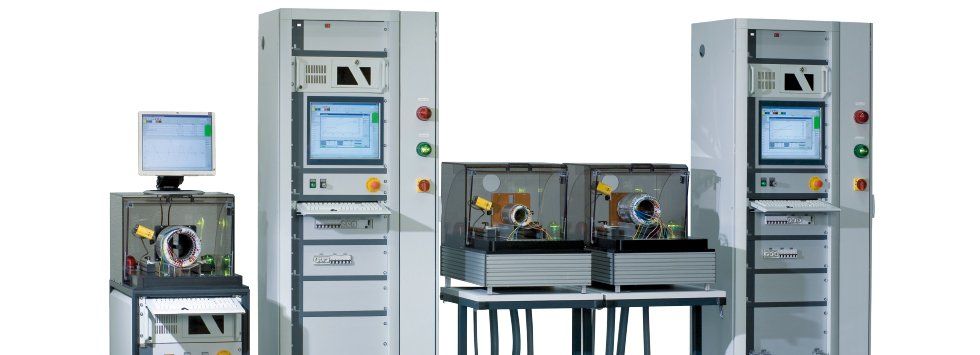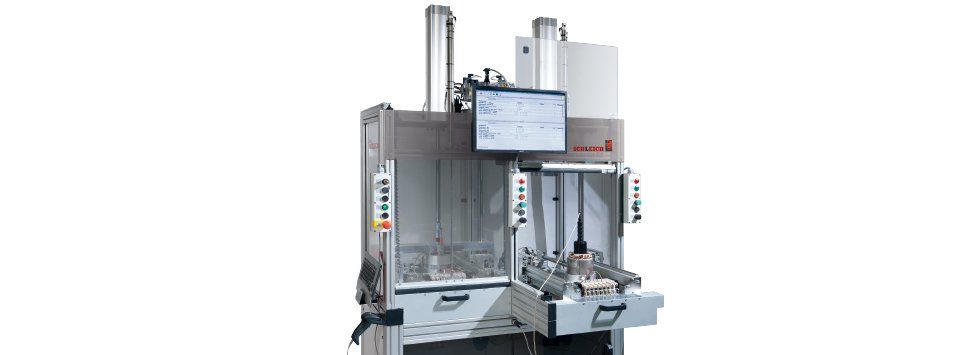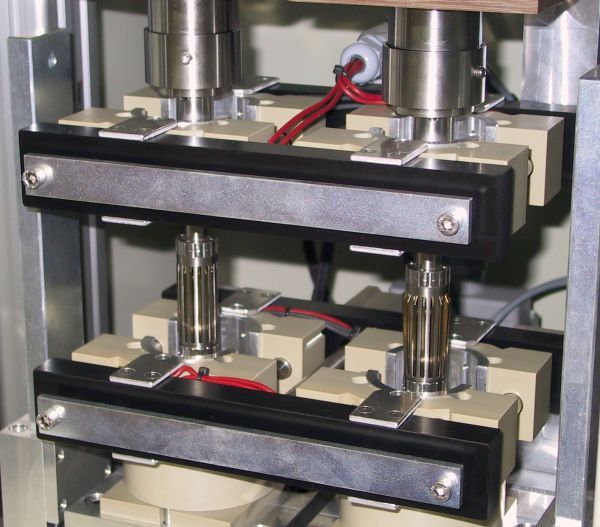Thermal bonding of windings and coils of any type
Thermal bonding of windings and coils of any type. We implement your individually designed automatic thermal bonding machines according to your specifications. We offer manual individual or multiple workstations as well as fully automatic systems for line production or rotary switching tables.
SCHLEICH bonding systems allow for up to eight simultaneous, autonomous bonding processes.
Thermal-bonding machines, impregnation & resistive-heating systems Universal systems for coil production
The bonding process is performed via a controlled electric bonding of the coils that is monitored by a computer. Depending on the current density there are different bonding times. The variation of the current density allows bonding processes that last from only a few seconds to some minutes. After the bonding phase there is the additional option to keep the reached temperature for a certain time constant. The result is a very uniform temperature distribution within the winding and thus a very good, uniform gluing of all winding parts.
Winding tests in its purest form.
SCHLEICH-bonding machines make it possible to bond and test self-bonding wired coils directly after the winding process. They allow the bonding and curing of coils for single- and three phase motors and all kinds of armatures and coils like speaker coils, magnet coils etc.
The bonding process is monitored by a PC and is performed by means of the controlled, electrical heating of the coils. Depending on the current density, different heating times result. Different current densities lead to bonding processes which may last from only a few seconds up to several minutes. After the heating phase it is also possible to constantly keep the reached temperature for a certain time. The result is a uniform temperature distribution within the winding and thus the best possible, homogeneous bonding in all parts of the winding.
Bonding variant: Constant voltage method
A constant voltage is supplied to the winding. With increasing temperature also the winding´s resistance increases and thus the current decreases. Consequently, with rising temperature less power/energy is transferred into the winding.
The advantage of this method is, that the temperature rises rather slow which results in a good and even stator heating. Thus, the temperature deviation between overhang and slot is ideally low when reaching the bonding temperature.
However, as the densest current in the wire can only be reached at the beginning of the bonding process, no short bonding time is possible.
Bonding variant: Constant current method
This method keeps a constant current level during the bonding process. To be able to keep the decreasing current level constant while the resistance increases, the bonding machine automatically increases the voltage during the bonding process. That is why the final temperature is reached in shorter time compared to the bonding method with constant voltage. However, at this, the temperature may be unevenly distributed in the winding.
The advantage of this method is the achievement of short bonding times. However, in most cases an uneven temperature distribution occurs.
Bonding variant: Constant temperature method During the constant-voltage or constant-current method the bonding process is stopped, as soon as the bonding temperature is reached.
The time, in which the self bonding coat melts at the wire´s surface and coalescenses with the neighbouring strands is relatively short at both methods. Due to this, it may happen, that the slot´s wires stay a bit cooler then the ones in the overhang, due to the surrounding laminated core. This could lead to a poorer quality.
With the constant-temperature method, as soon as the targeted temperature is reached, it is kept for a certain time. By this, the time in which the self bonding coat melts at the wire´s surface and coalescense
Bonding method: Temperature profile method
Bonding with a temperature profile basically corresponds to bonding with constant temperature, but, however, at this method, several temperature levels are reached one after another.
At this, the temperature difference between hangover and slot may aready be adapted during lower pre-temperatures before the actual melting process.
This method is mainly used in cases, where the laminated core is rather long (compared to a relatively short hangover) and/ or if the laminated core´s dimensions are rather large.
Reliable. Easily configurable. Reproducible. Highest precision.
Current-generated heat based on 30 years of experience
• Thermal-bonding machines for coils and windings of all kinds
• Impregnation systems with current/UV-curing method
• Heating with DC-current
• Heating with low-frequency AC-current
• Resistive-heating systems up to 100 kW, 1000 A, 1000 V
• Current densities up to 200 A/mm
2
• Five different methods to regulate the current-generated heat
• Temperature-controlled heating
• Temperature curve during the heating process
• Integrated 4-wire-resistance measurement
• Evaluation of winding-temperature sensors
• Simultaneous resistance measurement during the heating
process
• Online temperature monitoring
• Online connection monitoring
• Dynamic over-current sensor
• Monitoring of tools, grounding and short circuit,
switch-off time
≤50 µs
• Can be combined with additional tests like:
- Surge test
- Partial-discharge (PD) test according to IEC 61934
- High-voltage test AC/DC
- Rotary-fi eld test
- Insulation-resistance test, …
• Testing before and after the heating process
• Manual and automatic contacting units
• Forming tools and slot mandrels
• Heating cells, rotary-switching tables or production cells
• Integration into automatic production lines
• Integration into the IT of your company
Current-generated heat
Voltage, current and power matching your requirements
• Integrated power module DC or AC
• Five different methods to regulate the current-generated heat
• Temperature-controlled heating
• Continuous temperature detection during the heating process
• Graphic presentation of temperature and current
• Integrated over-current protection and fast switch-off
• Tool-temperature monitoring
• Super-fast measurement technology, 100 kSample ideal for
connection monitoring
• Highest measurement accuracy
• kWh energy meter per heating process
Test methods
Standard test methods:
• 4-wire resistance test from µΩ to 500 kΩ
• Simultaneous resistance measurement during the heating process
• Compensation of starting temperature
- Ambient-temperature sensor
- Infrared pyrometer
- Thermographic camera
• Visual examination
• Surge test up to 6 kV (only MTC3)
• High-voltage test DC (only MTC3)
• Insulation-resistance test (only MTC3)
Optional test methods:
• Partial-discharge (PD) test with surge voltage (only MTC3)
• High-voltage test AC up to 6 kV
• Partial-discharge test (PD) with high voltage AC
• Sense-of-rotation test of the rotary fi eld
Top Tier
Start input
• Two-circuit safety inputs according to EN 50191/VDE 0104
• Integrated Emergency Stop and connection for external
Emergency Stop
• Outputs for warning and result lamps
• Safety and warning messages
• Result outputs for Pass and Fail
• Status outputs
• Counter for operating hours and switching cycles with
maintenance instructions
• Cycle counter for tools with maintenance instructions
NAICS Codes
334515,
54138, 811219,811310
Cage Code
4P2J9
Duns Number
79-119-1351
Contact Info:
MOTOR DIAGNOSTIC SYSTEMS, INC.
inside.sales@mdsusa.net
Sales: +1 (970) 461-1348
or +1(877) 461-1348
Fax: +1 (866) 223-0800
Business Hours
- Mon - Fri
- -
- Sat - Sun
- Closed
All Rights Reserved | Motor Diagnostic Systems Powered by The Way Consulting








